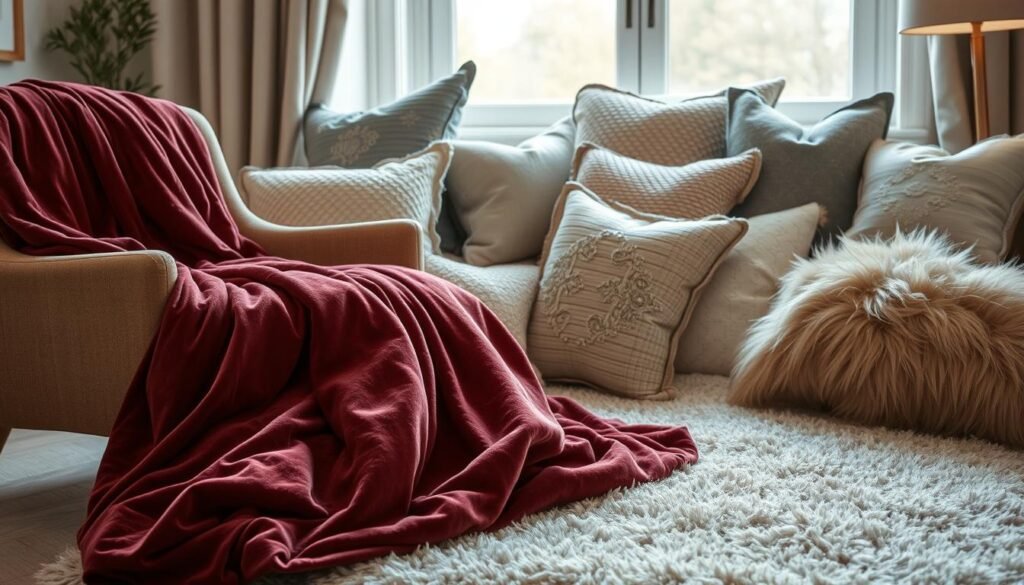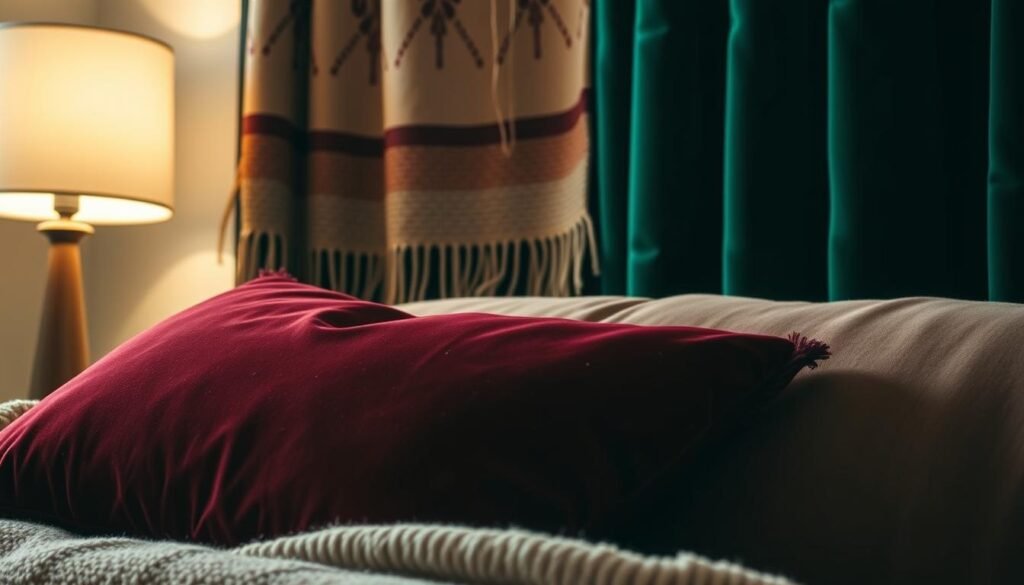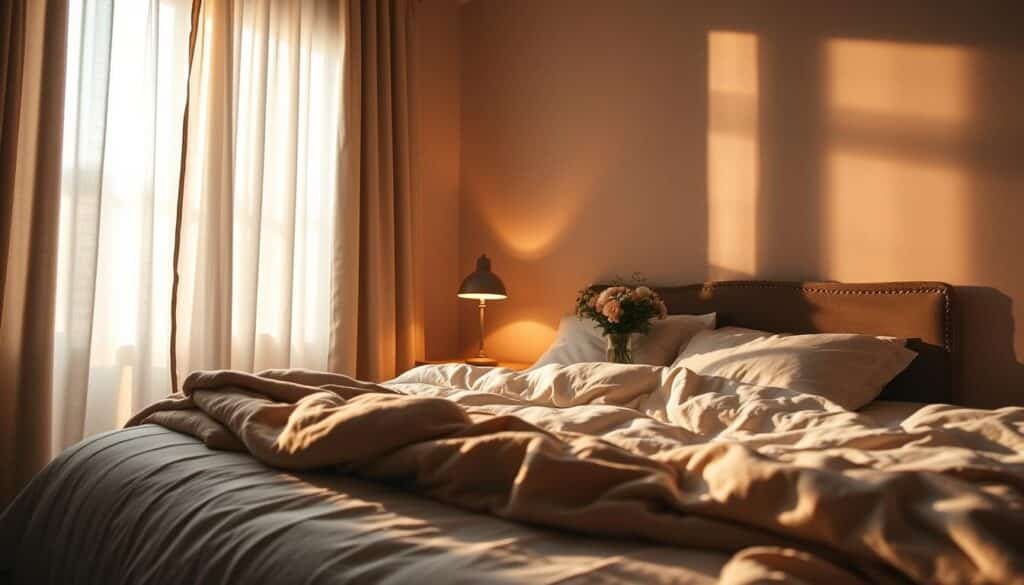This post may contain affiliate links. When you purchase through links on our site, we may earn an affiliate commission.
What if I told you that your home’s atmosphere isn’t defined by square footage or furniture costs—but by how it welcomes you? Years ago, I discovered that true relaxation lives in the details: the way light dances across a throw blanket, or how cushions seem to whisper “sit here.”
My method focuses on blending materials that beg to be touched with illumination that feels like a sunset. I’ve turned bland apartments into retreats using thrifted velvet pillows, hand-knit throws, and dimmer switches. It’s not about matching decor catalogs—it’s about crafting emotional resonance through sensory design.
You’ll learn how to layer fabrics so your sofa becomes a nest, and position lamps to erase shadows without harsh glare. We’ll explore why wool rugs make floors friendlier than cold tile ever could. Most importantly, you’ll see how even renters can transform sterile rooms into personalized sanctuaries.
Key Takeaways
- Combine contrasting textures like chunky knits and smooth linen for depth
- Use warm-toned bulbs (2700K-3000K) to mimic natural sunset hues
- Layer lighting sources at different heights for dimensional ambiance
- Rotate seasonal textiles to keep spaces feeling fresh yet familiar
- Prioritize touch-friendly materials near seating areas
- Incorporate subtle scent elements like lavender sachets or cedar trays
This approach changed how I experience my own living areas—and it can redefine yours too. Let’s begin where every great room starts: with the feeling you want to cultivate.
Embracing the Essence of Coziness
The magic of a welcoming room isn’t found in expensive decor—it’s in how it makes you feel when you sink into it. My journey with interior design taught me that textures and color work together like instruments in an orchestra, each enhancing the other’s impact.
https://www.youtube.com/watch?v=sWIYsQMHe8s
Understanding Texture and Warmth
I build rooms like I’m dressing a bed—layer by layer. A chunky knit throw over smooth leather? Yes. Silk curtains beside a nubby wool rug? Absolutely. As designer Emily Watson notes:
“Natural materials like sheepskin add grounding warmth you can’t fake.”
My secret: place touchable items where people naturally rest. Armrests get fuzzy blankets. Floors receive rugs thick enough to wiggle toes in. This tactile approach turns cold corners into zones of comfort.
The Role of Color in Crafting Mood
Color therapist Dr. Rachel Brown changed my perspective:
“Cool tones need warm partners to avoid sterility.”
I balance icy blues with terracotta pillows. Pale grays get paired with mustard yellows.
| Color Type | Emotional Effect | Best Uses |
|---|---|---|
| Warm Hues | Safety & relaxation | Main seating areas |
| Cool Tones | Calm focus | Reading nooks |
| Neutrals | Visual rest | Background surfaces |
I test paint samples at different times—colors shift with daylight. What looks cheerful at noon might feel clinical by moonlight. The goal? A palette that hugs you through all hours.
Curating Plush Textiles for Maximum Comfort
Have you ever noticed how certain rooms make you want to linger? That magnetic pull often comes from materials that engage both eyes and fingertips. Fabric specialist Jennifer Lee perfectly captures this:
“Textiles are like a hug for your living room.”

Material Magic in Three Dimensions
My selection process begins with touch tests. Rough burlap? Great for wall hangings. But for surfaces where skin meets fabric, I seek materials that reward contact. Wool forms my base layer—its natural insulation works year-round. Breathable yet substantial, it whispers quality through every fiber.
Velvet earns its spot through versatility. A midnight blue pillow adds depth to neutral couches. Emerald green drapes frame windows with luxurious texture. Unlike flat cottons, its pile changes with light, creating visual interest.
| Material | Best Use | Texture Benefit |
|---|---|---|
| Wool | Rugs & Throws | Temperature regulation |
| Velvet | Accent Pillows | Light-reflective depth |
| Faux Fur | Ottomans | Instant tactile appeal |
Faux fur serves as my secret enhancer. A single ivory throw transforms rigid chairs into inviting perches. Unlike real fur, it withstands daily use while maintaining its cloud-like feel. The key? Use it where hands naturally rest—armchair edges, footstools, or as bedside mats.
When combining these elements, I follow a simple rule: one heavyweight, one medium, one airy texture per zone. A wool rug anchors seating areas, velvet cushions add mid-layer softness, and gauzy curtains complete the trio. This progression guides occupants from firm flooring to plush relaxation.
How I Create Cozy Spaces with Plush Textiles and Soft Lighting
Mastering texture layering transformed my bland rooms into tactile wonderlands. Through trial and error, I discovered that the right combination of materials can elevate any living area from flat to fascinating. Let me share the techniques that professional designers use to build depth through strategic fabric placement.

My Personal Approach to Texture Layers
Every great room begins with a strong foundation. I start with neutral, high-quality fabrics on key pieces like sofas or area rugs. These act as blank canvases for layering, just as artist Greta Miles advises:
“Build your texture story gradually—rush it, and you’ll overwhelm the plot.”
My ‘rule of threes’ creates harmony without monotony. In seating zones, I combine a sleek linen couch with a nubby wool throw and silk accent pillows. This mix satisfies both eyes and fingertips, offering places for the gaze to rest while maintaining visual intrigue.
| Layer Type | Material Example | Design Impact |
|---|---|---|
| Base | Leather Ottoman | Provides structure |
| Middle | Knit Blanket | Adds warmth |
| Accent | Velvet Pillow | Introduces luxury |
Scale variations prevent sensory overload. I pair chunky cable-knit throws with smooth ceramic vases—the contrast keeps the space dynamic yet balanced. My non-negotiable? At least one touch-inviting element per zone, like a sheepskin rug that begs barefoot contact.
Final tip: Let textures tell your story. Drape that handwoven throw casually over the armrest. Cluster pillows in varying fabrics. Your room becomes not just a place to sit, but an experience to feel.
Mastering Soft Lighting Techniques
Lighting acts as the invisible conductor of your room’s emotional symphony. Sarah Thompson, a lighting designer with 15 years’ experience, puts it perfectly:
“The right glow can turn harsh corners into whispered invitations.”
My strategy focuses on sculpting light rather than simply brightening spaces.

Selecting String Lights, Lamps, and Candle Alternatives
String lights became my secret weapon after realizing their versatility. I weave them through bookshelves or nestle them inside glass vases for organic patterns of illumination. For lamps, I hunt for paper-shaded designs that cast leaf-like shadows – their diffused glow erases harsh edges better than any app filter.
My candle replacements? Flameless LEDs with irregular flicker patterns. Placed inside vintage lanterns or geometric holders, they provide safe ambiance that lasts through Netflix marathons. The key: cluster them in odd numbers near reflective surfaces like mirrors or metallic trays.
Lighting Temperature and Its Impact on Ambience
Bulb temperature transformed my approach more than any fixture. Cool white (4000K+) feels like a dentist’s office – warm tones (2700K-3000K) mimic firelight’s primal comfort. Here’s how I match temperatures to activities:
| Kelvin Range | Mood Effect | Ideal Location |
|---|---|---|
| 2700K | Relaxation | Bedside tables |
| 3000K | Socializing | Dining areas |
| 2200K | Meditation | Reading nooks |
I install dimmers everywhere – gradual brightness control lets rooms evolve with the day. Morning tasks get crisp 3500K light, while evenings melt into 2400K warmth. This biological alignment helps maintain natural circadian rhythms.
Incorporating Natural Elements and Greenery
Nature doesn’t stop at your front door—it should flow into your living areas. Biophilic design expert Dr. Michael Green explains:
“Bringing nature into your space can reduce stress and improve air quality while enhancing mood.”
My plant selections prioritize resilience and visual harmony. Peace lilies with their white blooms thrive in low light. Snake plants stand like sculptural sentinels, purifying air day and night. Trailing pothos vines soften bookshelves, their heart-shaped leaves cascading beside woven baskets.
Greens do more than decorate—they perform. Spider plants combat formaldehyde. Boston ferns add humidity during dry winters. I group them near seating zones where their benefits get noticed.
| Plant | Key Benefit | Care Level |
|---|---|---|
| Snake Plant | Oxygenates at night | Low |
| Peace Lily | Removes mold spores | Moderate |
| English Ivy | Reduces airborne feces particles | Medium |
Natural elements anchor rooms to the earth. A chunky oak side table grounds my reading nook. River rocks fill clear vases, reflecting light like water. In winter, pinecones nestle beside ceramic bowls—reminders of forests under snow.
Seasonal shifts keep my space connected to nature’s rhythm. Spring brings budding branches in clay pots. Summer showcases succulents on windowsills. Come fall, dried wheat stalks whisper of harvests. This rotation maintains freshness without redesigning.
Designing a Cozy Living Room Layout
The secret to a living room that feels like a warm embrace lies in its bones—not just its decor. Interior architect Lisa Chen taught me this truth:
“A focal point gives your space purpose and direction.”
I design rooms like I’m hosting a dinner party—every seat should feel intentional. My approach starts by identifying natural gathering spots. A fireplace? Perfect. No fireplace? A statement bookshelf or picture window works wonders.
Seating That Speaks Your Language
Instead of lining walls with furniture, I create conversation clusters. Two chairs angled toward a loveseat? Instant intimacy. A U-shaped sectional? Great for movie nights but needs balance. Here’s my formula for harmonious arrangements:
| Seating Type | Best For | Distance Guide |
|---|---|---|
| Conversation Cluster | Socializing | 4-6 feet between seats |
| Reading Nook | Solo Relaxation | Arm’s reach to side table |
| Media Zone | Group Viewing | 8-10 feet from screen |
Area rugs become invisible fences—a 9×12 under the main seating group defines territory. Task lighting marks reading corners, while pendant lights highlight the coffee table as the heart of the room.
Breathing Room Between Moments
Open floor plans need breathing spaces. I leave 36-inch walkways between furniture groups—wide enough for flow, narrow enough to feel connected. My favorite trick? Positioning a slim console behind sofas. It creates visual depth without eating floor space.
Every successful layout needs retreat spots. A wingback chair by the window becomes a reading sanctuary. An ottoman at the room’s edge offers respite from the main action. These pockets let people engage or observe—their choice.
Selecting Statement Furniture with Comfort and Elegance
Great furniture marries style with comfort effortlessly. I choose pieces that make eyes linger and bodies relax. Curved sofas and oversized chairs work magic—their soft lines invite you to sink in while adding sophistication.
Testing seating isn’t optional for me. I sit, recline, and read in every potential purchase. Does the armrest cradle elbows? Does the cushion support without stiffness? These details turn showroom pieces into daily sanctuaries.
Material mixing builds depth. A walnut table grounds velvet chairs. Brushed brass lamps warm linen sectionals. This balance keeps rooms from feeling flat or overly matchy. My rule? Three textures minimum per zone.
Investment-worthy staples anchor my design. A solid oak bookshelf outlasts trends. A down-filled sofa becomes family legend. Fewer high-quality items beat cluttered rooms every time. They whisper intentionality through every stitch and joint.
Every statement piece earns its keep. That marble-top console? Doubles as a bar cart. The leather storage ottoman? Hides blankets stylishly. Form meets function where design feels lived-in, not staged.

 using WordPress and
using WordPress and 
No responses yet